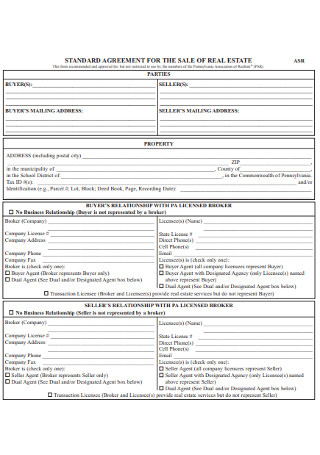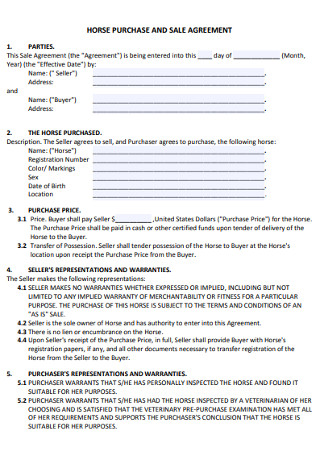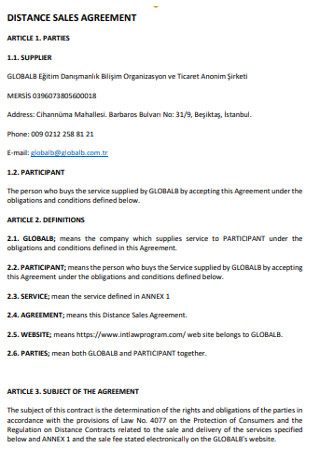A Sales Agreement is a vital legal document that outlines the terms and conditions of a transaction between a buyer and a seller. It defines the rights, obligations, and…
continue reading
“Less than 48 percent of businesses with multiple partners have a buy-sell agreement in place.” (Source: Forbes)
“3.4 Weeks – Average amount of time it takes to create and approve a contract.”
“An astonishing 85% of the companies surveyed are using manual or only partially automated systems to manage sales contracts.” (Source: Businesswire)

47+ Sample Sales Agreements
-

House Sale Agreement
-

Vehicle Sale Agreement
-

Basic Sales Transaction Agreement
-

Family Sales Purchase Agreement
-

Real Estate Sales Agreement
-

Master Rack Sale Agreement
-

Room Sales Agreement Example
-

Residential Property Sales Agreement
-

Equine Sales Agreement
-

Conditional Sales Agreement
-

Sales Purchase Agreement
-

Mobile and Home Purchase Agreement
-

Sales Employment Agreement
-

Sales Amendment Agreement
-

Second Hand Boat Sale Agreement
-

Horse Sales Agreement
-

Engineered Systems Sales Agreement
-

Bill of Sale security Agreement
-

Commercial Plot Sale Agreement
-

Sales Agency Agreement
-

Gas Sale Agreement
-

Binding Sales Agreement
-

House Property Sale Agreement
-

Motor Vehicle Sale Agreement
-

New Construction sale Agreement
-

Distance Sales Agreement
-

Sale of Shares Agreement
-

Retail Sales Agreement
-

Puppy Sales Agreement
-

Natural Gas Sales Agreement
-

Business Opportunity and Sale Agreement
-

Bid Form and Sales Agreement
-

Wholesale Sales Agreement
-

Group Sale Agreement
-

Sales Deposit Agreement Form
-

Coal Sales Agreement
-

Power Sales Agreement
-

Basic Online Sale Agreement
-

Simple Sales Agreement
-

Asset Sale Agreement
-

Marketing Sales Channel Agreement
-

Preliminary Real Estate Sales Agreement
-

Sample Sales Employee Agreement
-

Direct Sales Rep Compensation Agreement
-

Sales Contract Agreement
-

Conservation Credit Sales Agreement
-

Standard Sales Agreement Form
-

Guaranteed Sale Agreement
What Is a Sales Agreement?
A sales agreement is a kind of contract where the possession and ownership of a specific good or product are transferred directly from the seller to the buyer for an agreed upon sum. The price is normally fixed and is either already paid for or is still to be paid by said buyer at a future date. There are numerous variations of this, which depends on a variety of circumstances. Under most circumstances, this is a sales document that is drafted by attorneys, although one can also download editable templates that are available online.
Types of Sales Agreement
There are multiple variations of sales contracts and agreements that differ according to the circumstances in which the sale is made and what the parties have agreed on regarding what happens after the ownership title has been passed. Check them out in the list below.

How to Draft a Sales Agreement
Things like sales contracts, sales flyers, proposals, and the like are easily available as downloads online. For those who are in need of a sales agreement but prefer to make one from scratch rather than download a template, then the following step-by-step instructions are guaranteed to make the experience easier and faster.
Step 1: Negotiate the Terms of the Sale with the Buyer
Before you can get started on creating the document itself, you must first discuss the terms of sale with the buyer of whatever it is that you are trying to sell. Take note of the essential terms. These would include the price of the product, the particular method of payment, the specific delivery date, and many others. You are advised to not just keep in mind your own concerns, but also anything that the buyer may have on his or her mind, such as the product’s warranties. Once the negotiations are done, you can proceed to draft the sales agreement properly.
Step 2: Gather the Necessary Background Information
There are certain types of information that you will need to learn if you are to continue drafting the sales agreement correctly. Said information will include the title of the product to be sold, along with any ownership documents that are involved. As an example, if you are selling a vehicle, then you will need its original title so that you can complete the sale in the most valid and effective way possible. An alternative example would be for those who are selling land or properties; conducting their own research is needed to see if the ownership is not disputed.
Step 3: Begin with the Basic Information
One of the first things to write would be a short statement that properly explains what the document’s purpose is. Follow that up by writing down the names of the seller, the buyer, and anybody else that is involved in the sale. Be specific with the information you write down in this part of the sales agreement. You can also include your complete sales price, along with what kind of payment method the parties have agreed to.
Step 4: Write Down the Specific Description of the Product
Just like with the names of the parties involved, be as specific as you possibly can be when coming up with the description of the item that is to be sold. For example, should the item be a car then you need to include its VIN or vehicle identification number. Also, state if it is a new car or if it is something older that needs to be restored in some shape or form. When applicable, the model type or a serial number is also going to be necessary as identifiers.
Step 5: Write Down the Details of the Item’s Delivery
If the item is something that the buyer is willing to personally pick up, then it would still be necessary to state that in the agreement. Should the agreed-upon method of delivery involve you sending it to the buyer’s indicated address, then include all the necessary details as well, including the expected dates of delivery. In the event that a third party is tasked with the delivery, then include provisions that state how you are not liable for any damage incurred while it is shipped.
Step 6: Write Down Disclaimers and Warranties
To minimize any risk for all the parties involved, do not neglect the disclaimers and warranties. Go in detail regarding the condition of the product that is about to be sold. This will include acknowledging if the product is going to be sold to the buyer ‘as is’ or otherwise. By doing so, the buyer can be informed that the seller is not responsible for any present defects or damages. For the warranties, this will reassure buyers regarding the specific quality of what is being sold.
Step 7: Include Any Extra Provisions that Arose from the Negotiations at the Start
Before you can wrap things up and have the agreement signed, it is worth looking back at the negotiations at the start of this process. Any extra provisions will need to be included to ensure that nothing is left to chance and for all parties to be assuaged of any concerns that they might have.

The Do’s & Don’ts of a Sales Agreement
By now, you should be better acquainted with the knowledge of how sales agreements are drafted. From there, the next step would be to improve on what you’ve come up with by learning about the essential do’s and don’ts. On their own, there are issues that are minor at its worst and even inconsequential at best. However, with too much of them lumped together, you may find that your sales agreement is a lot less effective as you might have expected. Take note of these suggestions and ensure the high quality of your sales agreement.
The Do’s
Do include all the relevant information
There is a reason why people want to put the details of their sales transactions into writing. By including all of the relevant information, you can drastically improve the quality of your legally-enforceable document and keep it as effective as you want it to be. All parties involved want to get out of the deal with as many benefits as possible, so do not neglect anything that could help them achieve that desire. For example, if the agreement pertains to the sale of just one part of a machine, then it is important to specify that. Should the seller agree to deliver said machine part on a specific date and no other, then you need to include that in the sales agreement.
Do take the time to number paragraphs
Have you ever seen a legal document where each paragraph is assigned with a specific number? The reason for this is quite simple: to make sure that the document is kept as organized as possible. Should one or more of the parties involved with the agreement feel the need to review the drafted sales agreement, then having numbered paragraphs will make their efforts far less troublesome and much quicker to do. There will not be any need for anyone to read it all from the very beginning; instead, all anybody could do would be to simply look for the number of the specific paragraph that needs to be reviewed and they are more or less good to go.
Do try to write in a way that is as easy to understand as much as possible
The language used in legal documents can be difficult to understand already. If you go out of your way to use overly complex or even archaic phrases, then you will end up making it even more difficult. Ensure that you write up the sales agreement in a more modern language. That way you can prevent fewer misunderstandings that may lead towards litigation. Also, it will be much easier for either party to hold up their end of the bargains or push through with their required obligations if they actually understand the agreement that they are entering into.
Do your best to avoid as much ambiguity as you possibly can
Those who deal with contracts and agreements on a regular basis can tell you just how prevalent it is to come across moments of ambiguity in any given document. Such things happen because contract language makes it easy for ambiguity to rise, which then leads to unnecessary and ultimately avoidable disputes. With the knowledge of how easy it is to get into such messes, avoiding ambiguity as much as possible is now a priority. As a seller, you and your partners need to consult with competent professionals so that you can do just that. Even words like ‘or’ and ‘and’ can lead to ambiguity if one isn’t careful.
Do your best to utilize other terms instead of just using ‘material’
Many might think that the word ‘material’ is harmless. On its own, it certainly can be. Even using it once every now and again can be perfectly safe. However, there is a consideration you must take when using the word for your sales agreement. Remember that this is a tricky word due to its vagueness and propensity towards the creation of ambiguous statements. To avoid any unnecessary complexities or issues, rely less on its usage and instead use more specific words in its place. The writing part of the sales agreement might have become just a bit harder, but you’ll thank yourself at a later date for the smooth sailing that you just put yourself and all others involved parties on.
The Don’ts
Don’t go overboard with jargon
What could be worse than using terms that only few people would understand? Using terms that you don’t even understand. There can be a time and place for jargon, but a sales agreement is not the place for anybody to overuse them. Many include obscure words and terms for various reasons, but if the intention is to come off as smarter than you actually are, then you are going about it the wrong way. Keep whatever jargon you plan on using to a minimum and even then, it is best to define it for the benefit of your document’s readers.
Don’t use unnecessarily long or complex sentences
It is important to communicate in ways that people won’t have difficulties with. Oftentimes, that has more to do with the words or phrases utilized. Even when you are using modern language, difficulty can still arise if your sentences are too long for most people to follow with ease. Rather than come up with one long sentence, it would be better if you broke it down in half so that it becomes easier to digest.
Don’t go overboard with ‘shall’
A sales agreement does not need to be carelessly littered with just any type of word. Using ‘shall’ is permissible if you come across a section of the document where obligations are to be created. Other than that, the use of the word is dubious at best. Despite that, there are many contract or agreement drafters that liberally throw ‘shall’ around as if the document they are writing won’t be enforceable without it. By overusing the word, you run the risk of unnecessary complexity.
Don’t include irrelevant information
Contracts do not need anything that isn’t relevant to the topic at hand. For sales agreements or contracts, there are many details that you need to include. For example, the names of all involved, their addresses, the items sold, its descriptions, and various others are all considered relevant. However, trivia like what other colors the product is available in or when it was first invented are clearly not relevant to the sale. Don’t make the agreement longer and stick directly to the point.
Don’t limit yourself to traditional drafting
There are multiple reasons why tradition can survive all those who started it in the first place, but that does not mean that everything is automatically perfect or that there is no room for any alternatives or even improvements. That statement is true as far as traditional contract drafting is concerned as well. As a matter of fact, there are glaring flaws in terms of the entire process and the quality of documents created from it makes it something you would be better off avoiding every now and again. Deviating from the norm might seem intimidating, especially for those junior lawyers without much experience, but there are times when the results are greater than expected.
After all of that, you ought to know by now that sales agreements are clearly professional-level documents that should not be taken lightly by anybody. The nuances can certainly run deep, but as long as you are armed with the right knowledge, then it is quite possible for any seller and buyer to have the right one capable of catering to their specific needs. Those who do not want to start over from the beginning can rest easy knowing that amazing resources are readily available. Sales agreement templates or sample contracts can be found online and are not only made by top-notch experts but are also easy for anybody to edit and are printable for the convenience of the user.

